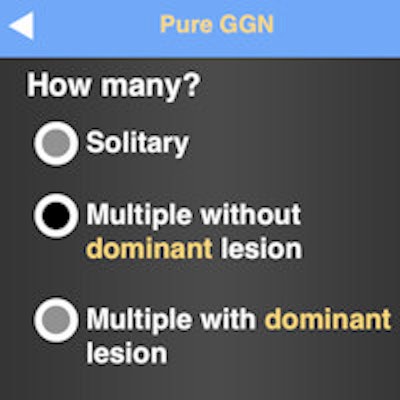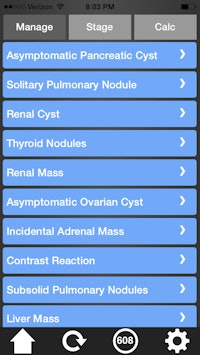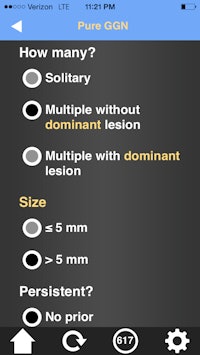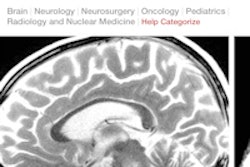
AuntMinnie.com presents the next article in an ongoing series highlighting notable mobile apps in radiology. In this installment, we take a look at RadsBest: Fast Decision Support for Radiologists, an iOS app that offers a number of features aimed at helping radiologists improve the quality, usefulness, and consistency of their reports.
We chatted recently with developer Dr. Roy Kwak, founder of mobile app software firm Medocratic, to learn more about RadsBest. In addition to his responsibilities with Medocratic, Kwak is a neuroradiologist with Focus Medical Imaging, a radiology group in Alhambra, CA, and also performs teleradiology.
 Dr. Roy Kwak, neuroradiologist and founder of mobile app software firm Medocratic.
Dr. Roy Kwak, neuroradiologist and founder of mobile app software firm Medocratic.AuntMinnie: What inspired you to create this app? What problem does the app solve or help to make easier to handle?
Kwak: Have you ever had the situation where you are about to read a CT for follow-up and you think, "What joker recommends following a 2-mm nodule in three months?" Then you scroll down to the bottom of the prior report and see your own name? Well that's happened to me, and it makes me realize how inconsistent I am with my own recommendations for management, both from patient to patient and within a single patient's timeline. Now add in the variability of your colleagues' recommendations and your clinicians are probably pretty confused. It is just a reality of modern practice. At the pace that radiology happens nowadays, it is a struggle to just provide useful recommendations, let alone recommendations that are optimal and also consistent.
So when the first American College of Radiology (ACR) white paper came out with guidelines for the management of incidental findings, I thought it was great. It would theoretically help deal with these clinical dilemmas that we encounter daily in our practice. For patients who fit the inclusion criteria, it provided a management recommendation that was supported by the ACR. While that was fantastic, the problem was, though, that I would either have to memorize it, look it up every single time, or tile my reading room with flowcharts. That's an issue if you read from multiple locations.
If you want people to use something, you have to make it really easy. A great example of this is the Fleischner Society Criteria. If you want to talk about algorithms, you can't get much easier. They were initially published way back in 2005, and although there are papers showing that radiologists have been incorporating them more over time, in my experience, in the community setting it is still entering the zeitgeist and it has been 10 years! There are a lot of hurdles, but I think that one of them is that even this easiest of guidelines is not easy to remember ... and busy radiologists just don't want to look it up.
My primary goal with creating RadsBest was to make all of this super easy, and the great thing about it is that it doesn't just make the guidelines easier to use, but it also collects them all in one place, making them more visible. In so doing, I think that it will prove to short-circuit the time it takes for these guidelines to enter the mainstream and actually affect patient care.
How was the app developed? And can you share some background on Medocratic?
 RadsBest offers management decision support for radiologists, a cancer staging tool, and commonly used calculators for radiology. All images courtesy of Dr. Roy Kwak.
RadsBest offers management decision support for radiologists, a cancer staging tool, and commonly used calculators for radiology. All images courtesy of Dr. Roy Kwak.It's really a remarkable time. So many resources are out there right now if you want to improve your computer language literacy. At the time I developed this app, I had learned some basic HTML, CSS, Javascript, and Python -- all online and all for free. With that knowledge, I created the first prototype of this app on the Web with the help of a good friend. After I got some feedback from that early version, I decided to make the leap to iOS. At that point I hired a couple developers to help with the heavy lifting, since it wouldn't have been efficient for me to be doing all the backend work when I was still working full time. I focused my energy on creating the content, user interface, and design.
RadsBest was launched as Medocratic's first product. There are tectonic shifts happening right now in the world of health IT. Things are moving so fast and systems are so complex that when it comes to introducing new technologies -- the same ones that you depend on day in and day out -- the actual practicing doctors who will be using them often don't have enough input, or the systems are so complex that even with said input you can't really know what you are getting until it is too late to turn back.
I kind of see Medocratic as a counterbalance to that. Any radiologist can just go and download the app and decide to use it or not. Our goal is simple: make software that makes doctors happy. I believe that if you give doctors well-executed tools that make doing an awesome job easier, then docs will just do that, and be more awesome.
Who is the target audience for your app, and how do you envision that it will be used?
Well, any practicing radiologist with an iPhone, really. I think that all radiologists could potentially find RadsBest useful in their practice. It helps them create actionable reports with recommendations that are supported by guidelines. And it helps them make recommendations that are consistent over time.
What are the app's most important features?
The app currently has three main functions. The first is the one that we have been discussing, management decision support. We currently have tools for 18 different clinical scenarios. The second is a staging tool that provides easy calculator-like staging for many common cancers. Currently, there are 11 cancers included and more on the way. We can add more tools through the cloud, so the app is growing over time. Finally, the app has the ability to perform some basic calculations that are common in radiology.
 RadsBest tools can, for example, help radiologists adhere to the Fleischner Society Criteria for managing solitary pulmonary nodules.
RadsBest tools can, for example, help radiologists adhere to the Fleischner Society Criteria for managing solitary pulmonary nodules.How many users do you currently have for the app?
We launched in mid-2013 and have had a steady increase in the number of users. We currently have approximately 2,250 registered users from around the world. The most popular tools have consistently been the tools for the Fleischner Society Criteria for solitary pulmonary nodules, management of asymptomatic ovarian cysts, thyroid nodules, and adrenal masses.
What are your future plans for the app? Any new features or content in the works?
We are going to be adding a lot more tools to help with management of other commonly encountered clinical dilemmas. I am also working on a feature that will allow users to store their own notes and data within the app.
When I first launched RadsBest, iOS was the dominant platform amongst radiologists, and with the release of the new iPhone I believe that it still is. Although we don't have solid plans to develop an Android version at this moment, it is part of our larger plan and will be important to gaining as many users as possible.
Have you developed any other apps or plan to?
I just released an app that is directed for clinicians called StageBetter, which is basically a standalone American Joint Committee on Cancer (AJCC) TNM Classification of Malignant Tumors (TNM) staging calculator drawn from the one that is currently in RadsBest. I am also starting work on another app focused on easing physician communication, but it is probably still too early to discuss the details.
RadsBest: Fast Decision Support for Radiologists can be downloaded for free from the iTunes App Store.




















